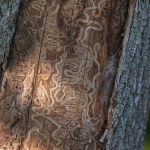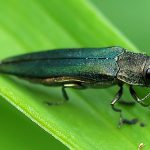Emerald Ash Borer
Identification:
Emerald ash borer (EAB) are long and thin with a squared off head, a straight body, and a rear that tapers to a blunt point. They have many look-alike species so it is important to look for key details before being sure that what you are looking at is an EAB. If the insect is rounded, or looks pinched in in the middle, it is probably not EAB. They have hard shell-like wings that hide and protect their clear hindwings when they are resting. If you see clear wings on a resting adult, it is not EAB.
They are easiest to identify by the damage they cause. Many ash groves in Massachusetts have already been destroyed, leaving stands of dead ash trees in their wake. The beetles create extensive, zig-zagging “tunnels” just below the bark layer of ash trees.
Control:
Emerald ash borer prevention is similar to that of other wood boring insects. A key step is to limit the movement of wood. This means you should never bring firewood or other deadfalls from one location to another. Get all firewood locally, for even if there are no beetles visible, the infestation can still spread. Another important part of this is leaving deadfall where it lies, as removing logs, branches, and wood debris from your yard can further spread these beetles. If you see any beetles you can successfully identify as EAB, you should document and report your sightings, and then smash the bugs.
If you have a tree on your property that is infested with emerald ash borer, the best course of action is to hire a professional. By injecting insecticides into the tree, or other chemical treatments, the tree has a chance of surviving.



